Things to check before buying your first Cartier Must Tank
Click here to watch the video guide to buying your first mast tank.
This article is aimed at beginners and provides various explanations about the "Must Tank" created by Cartier, one of the most popular vintage watches, for those who are considering purchasing one.
We will explain in detail about the history of Must Tank, the size, the difference between hand-wound and quartz, wearing reviews, and maintenance.
By reading this article, you will have about 90% of the knowledge about mast tanks, so please read to the end.
What is a Mast Tank?
This model is popular with both men and women, and its timeless design makes it a great choice for both casual and formal styles.
Speaking of which, the price of new Cartier watches has risen significantly last year, so it could be said that used Mast Tanks are a model that everyone is after.
Looking back at its history, the Mast Tank was born in 1978 and was produced until 2005.
The Santos was born around 1894, and the Tank around 1910, but until the 1960s, Cartier watches were made exclusively from 18k gold and only high-end models were available.
However, as time passed, young people were now able to afford to buy the brand, so the Mast series was launched as an affordable line to attract this demographic.
By the way, the word "must" means "you have to do something," but in Cartier's terms it means "you have to have it."
The Mast Tank was produced for about 30 years, during which time a variety of different dials were created, and they are all available to us today.
Therefore, they are not sold new and can only be purchased at vintage watch shops.
Mast tank case features
The Mast Tank was originally created as a popular version of the Tank, so its shape is almost identical to the Tank Louis Cartier.
Someone unfamiliar with Cartier would probably not be able to tell which is which at a glance.
In addition, the case material has been changed from 18k to pure silver vermeil, which is a plating technique that involves applying multiple layers of 18k coating.
By the way, the mast tank is plated with a thickness of 20μ, which is the equivalent of 200 sheets of gold leaf, so you can see that it is very thickly plated.
Now let's compare hand-wound and quartz watches.
What is the difference between hand-wound and quartz models?
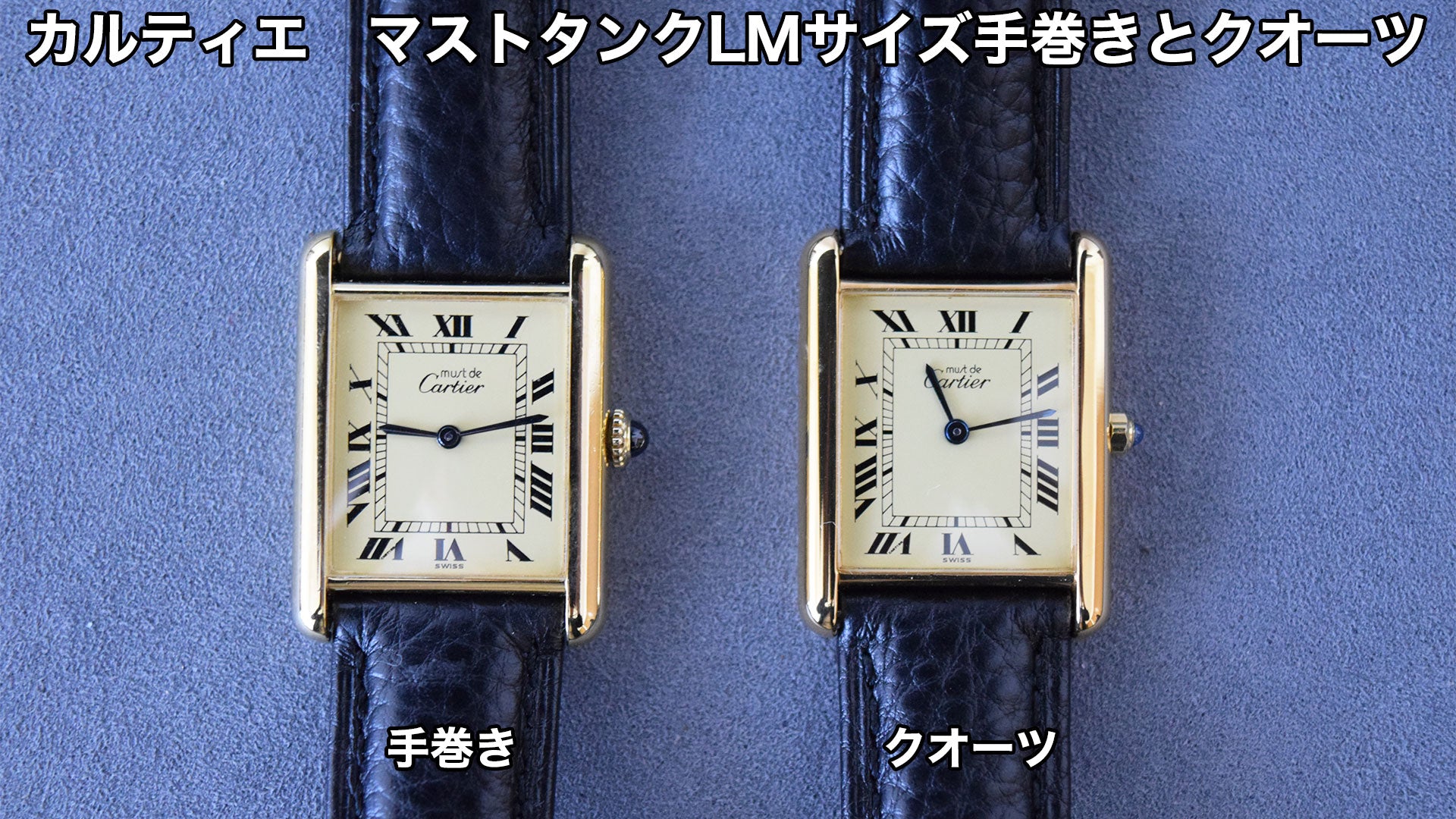
First of all, you can't tell the difference when looking at the display.
They both have the same dial and are the same size.
Now let's take a look at the back.
If you look at the back, you can immediately see that the manual winding model has a snap-on back cover.

For the quartz watch, the back cover is also screwed in place and has the inscription " It says ``Quartz''.
Both have the number 925, which represents the purity of the silver.
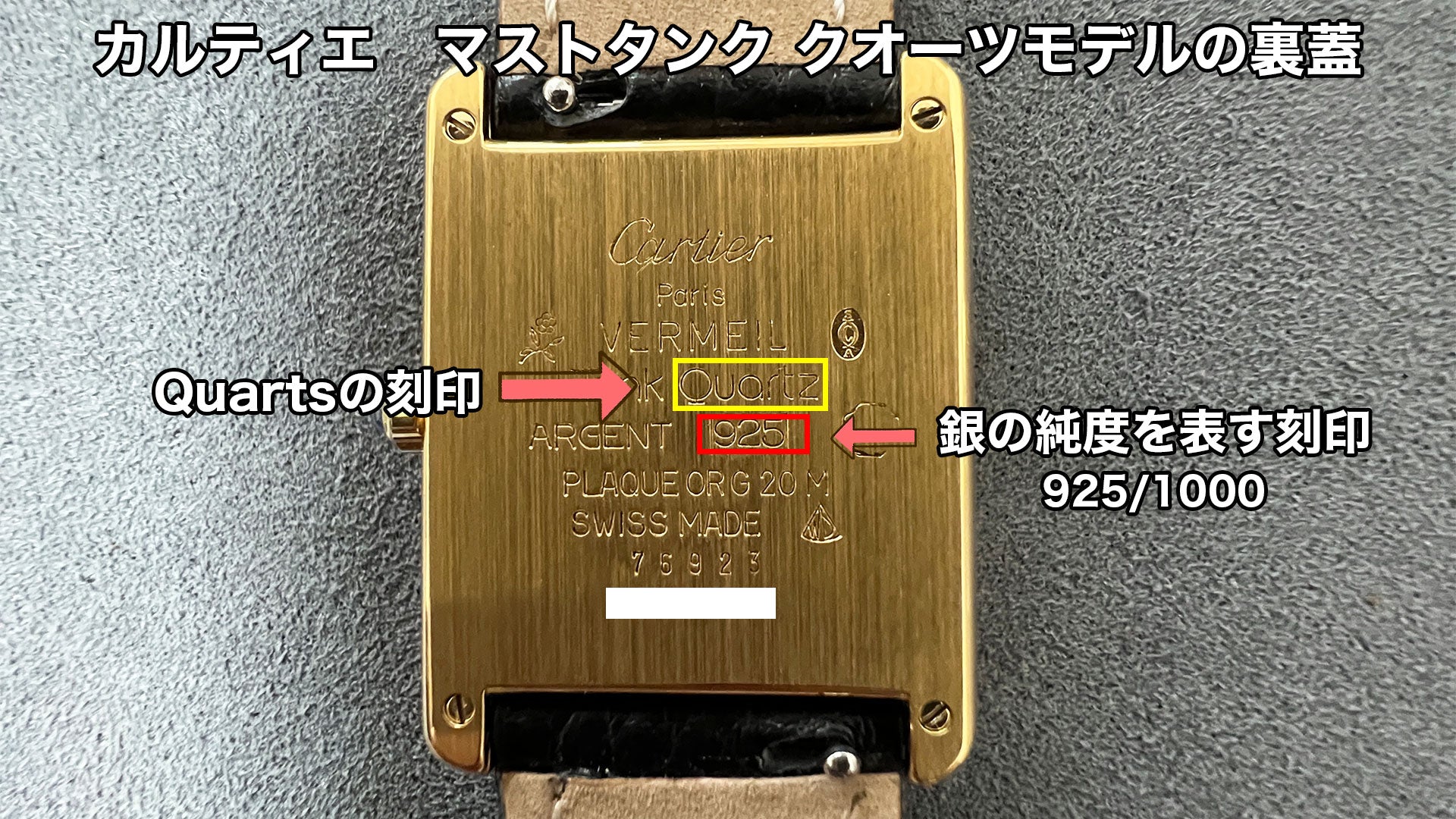
There is no standard for classifying silver as pure silver, but generally it must be 925/1000 or above, and this number is used to prove that.
There are a total of four screws on both sides of the side, so just like with the display, there is not much difference, but the manual winding watch is just a little bit thicker.

When you think of Cartier, the first thing that comes to mind is probably this ivory dial, but there aren't many Mast Tanks available in both hand-wound and quartz models like this one.
This is because, after the invention of quartz by the Japanese company Seiko in 1978, various Swiss watch brands introduced quartz movements.
The same was true for Cartier, where quartz movements, which could be produced cheaply, were compatible with Mast Tank watches, which were designed to be produced cheaply, and so the proportion of quartz in their watches increased.
So the dividing line is that early models made in the 1970s, for example, have both hand-wound and quartz models, while later models (dials) are only quartz.
This is just my personal opinion, but no matter how many Mast Tanks you have, you can have fun changing them depending on your mood that day, so I don't think you need to worry about whether they're hand-wound or quartz.
Men in particular tend to see quartz as inferior, but it would be a shame to think that way when it comes to a Cartier watch, so I think it would be a good idea to change the way you look at quartz.
If you don't particularly care about mechanical watches and this is your first watch, we overwhelmingly recommend quartz.
My views on "mechanical" and "quartz" are explained in detail in this video, so please take a look if you are interested.
When this topic comes up, something that also needs to be explained is maintenance.
Now, I'll explain about maintenance.
Mast tank maintenance
I just recommended quartz!
I have shared my opinion above, and the reason is that if it is a quartz watch, almost any watch shop will do it.
Since the people reading this article live in different areas, it is difficult to say that one place is best, but it makes a big difference whether or not there is a store nearby that will change your watch battery when it runs out.
Also, most stores that do battery replacements can also repair quartz watches.
When it comes to mechanical watches, there are fewer shops that can repair them compared to quartz watches, so it might be a little difficult to find a shop that can do the work. That's my impression.
This does not apply to everyone, but most people who use larger stations have a Mister Minute, which can also provide battery replacement and repairs, so if you have one nearby, why not try it out?
Of course, we can handle such repairs and can also solve problems unique to mast tanks.
Please see the image below.
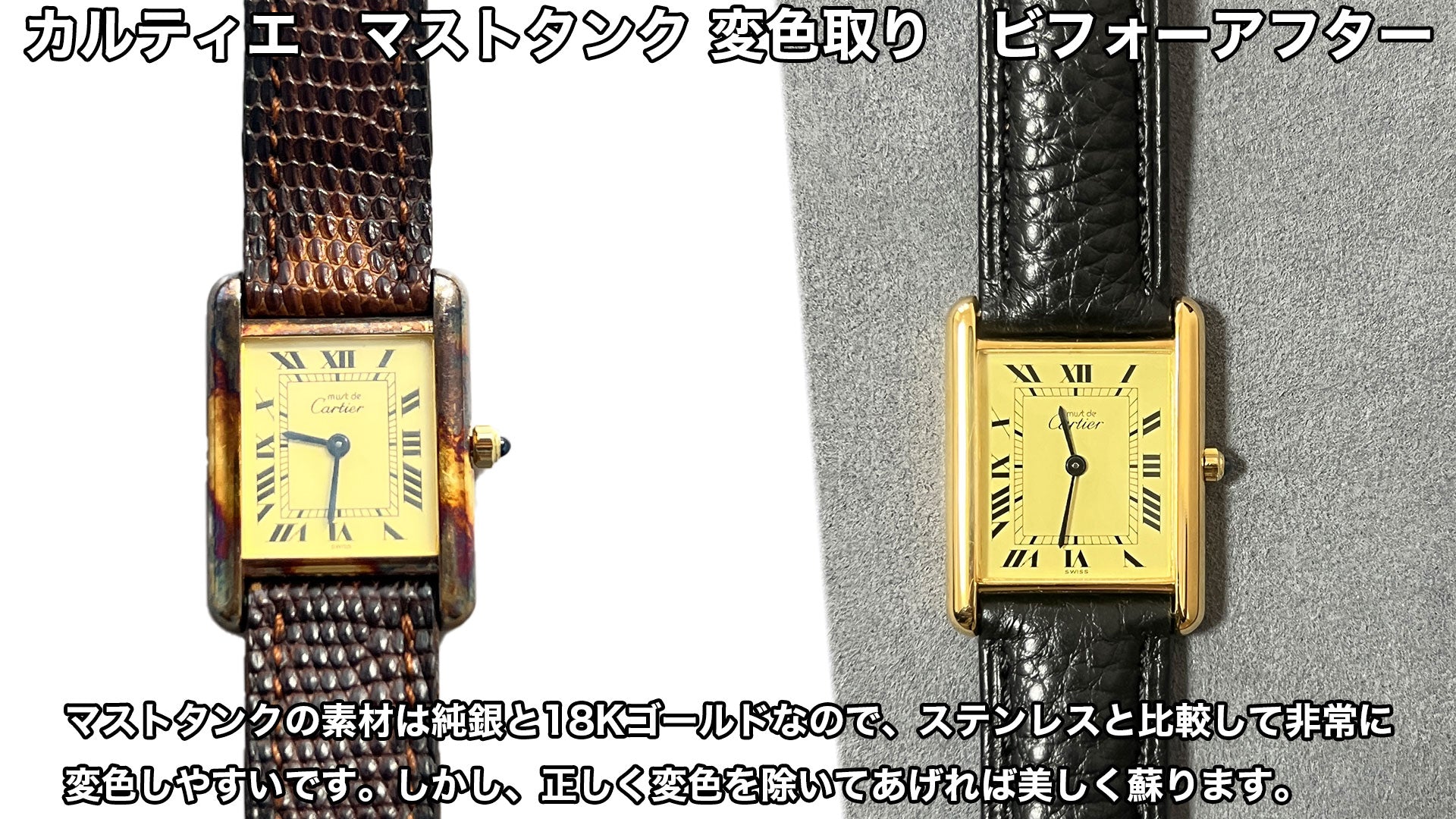
As explained in the section on case material, the Mast Tank case is made from pure silver and is prone to tarnishing.
If the color has discolored to this extent, it will no longer be possible to wear it, and you will have to just leave it as it is.
In the image above, the scratches have been removed and the item looks quite clean, but even just removing the discoloration will bring the exterior back to beauty.
Next, please take a look at this image.
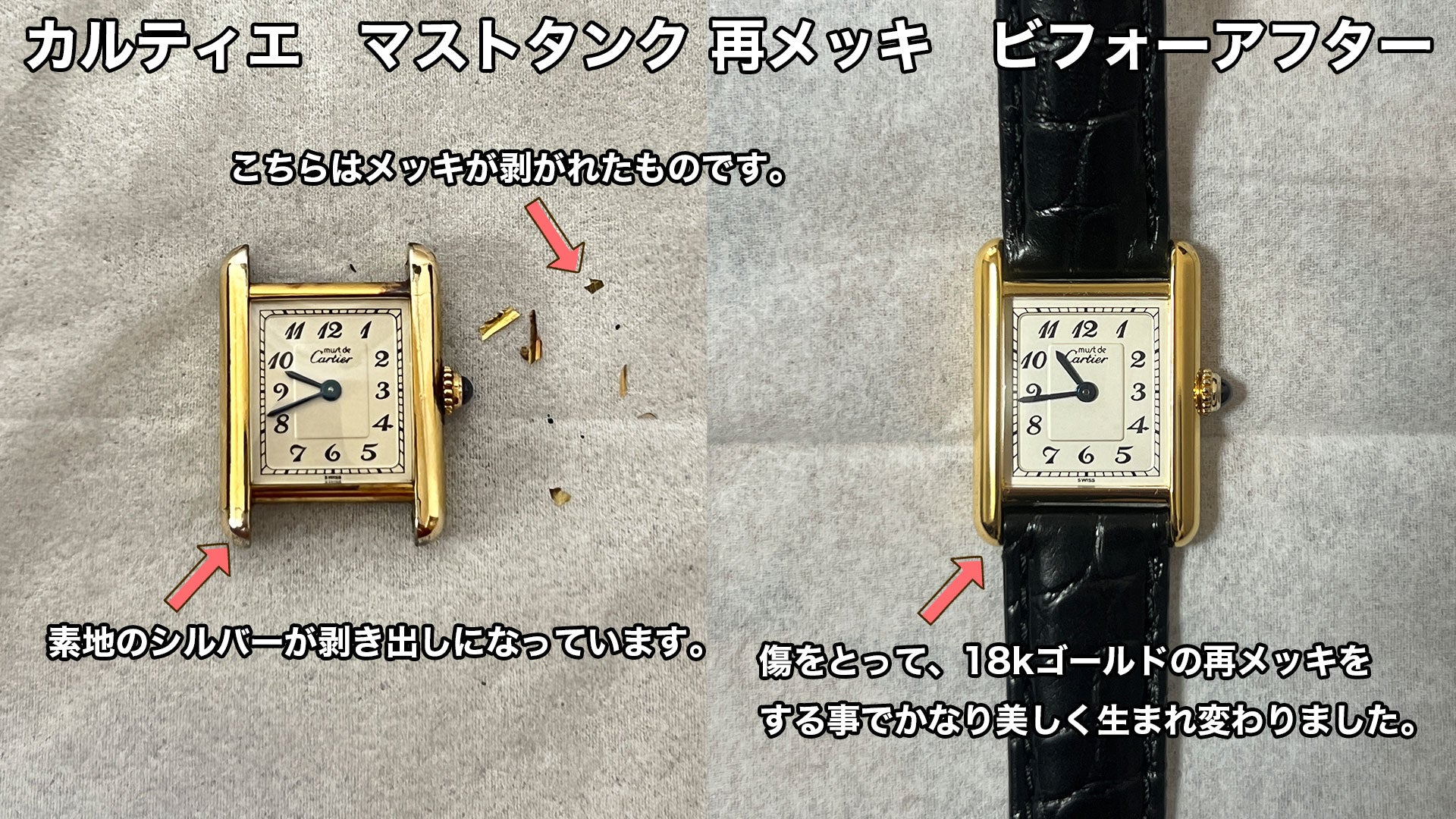
This is a mast tank that was in poor condition. As shown by the arrow in the photo on the left, the plating has peeled off, exposing the underlying silver.
If it looks like this, it will be difficult to wear and will need to be re-plated, and the photo on the right shows it after that.
This one too has been restored in a very beautiful state.
If you wear it, it will inevitably get scratched, and over time there is a high probability that the plating will discolor or peel off.
That can't be helped, but if you can use it for a long time instead of leaving it like that, you'll feel even more attached to the watch.
Of course, we can remove discoloration like this and re-plate the item, so please feel free to contact us for any inquiries, including repairs.
Now let's take a look at the images and see the size.
Let's take a look at each size
In this photo, the left is SM size and the right is LM size.
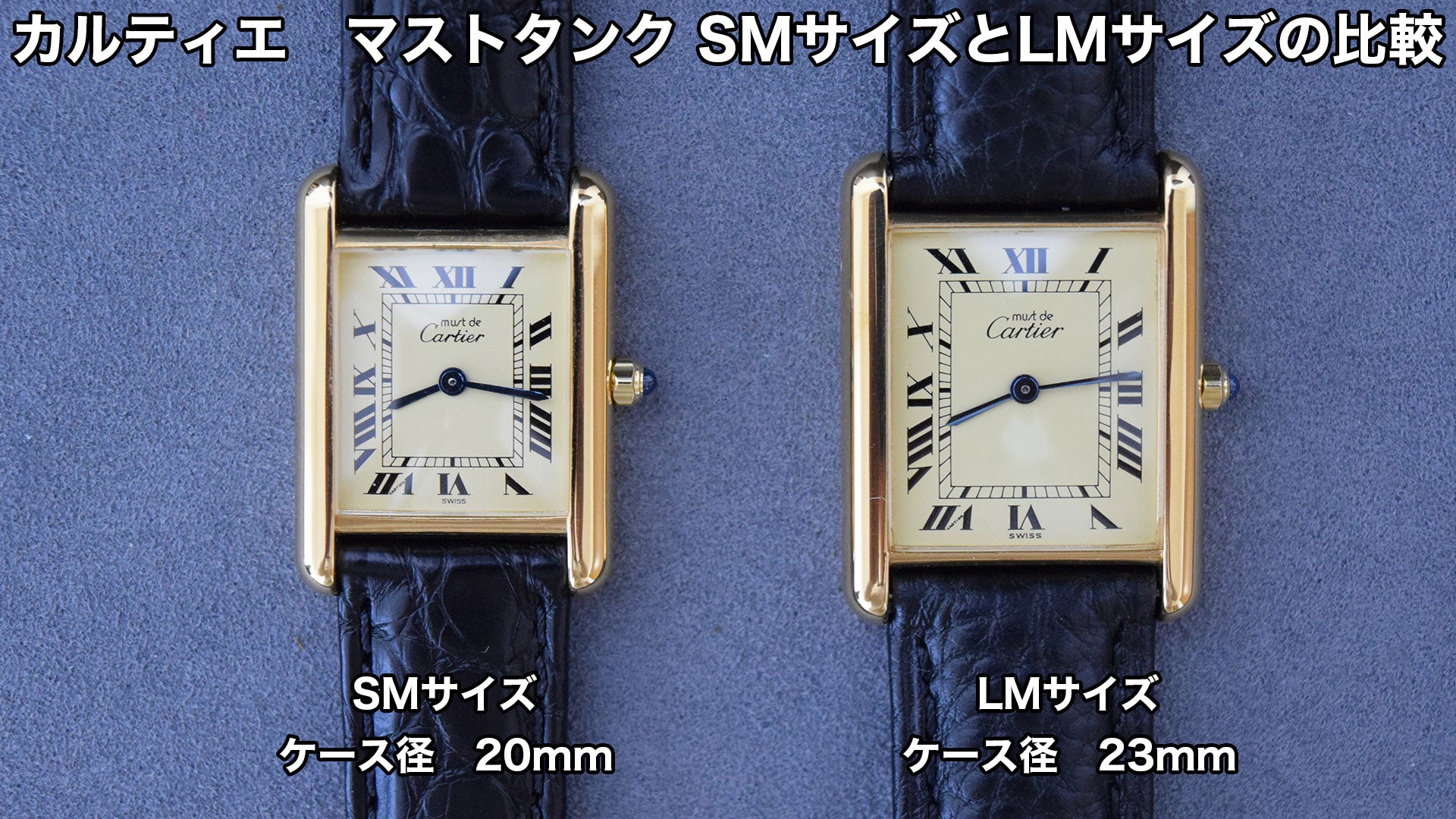
In terms of sizes, there are SM, MM, LM, and XL, but most of what we see are SM and LM.
This is because when the Mast Tank was first released, the lineup consisted of these two sizes, with MM and XL being added later on.
Therefore, you don't see MM and XL sizes very often.
Returning to our previous discussion, generally speaking, SM is for ladies and has a case diameter of 20mm, while LM is for men and has a case diameter of 23mm.
That said, there are also many men with thin wrists who purchase SM watches, and I think that these people have a great fashion sense because they know what size is best for them.
Of course, the same idea applies to larger sizes for women.
Size is just one indicator, so the best choice is to choose the size that suits you best.
This photo shows a woman with a wrist circumference of about 14cm wearing the SM and LM sizes.

The one on the left is the LM size and the one on the right is the SM size, and both seem to fit comfortably without any discomfort.
The term "LM size" sounds large, but the SM size of the current tank mast line is 22mm.
So it's almost the same size.
As the era approaches modern times, the base size of watches has gradually become larger, but in the late 1970s, this size was still considered LM.
I'm an SM size, but this one is quite small.
I don't think you'll find this size in most other brands' current lines.
I think the reason why mast tanks are so popular among women is largely due to their size.
After all, most women prefer small pieces that are more like accessories rather than larger ones, and for many Japanese women with slender wrists, SM is just the right size.
Now let's look at the men's.
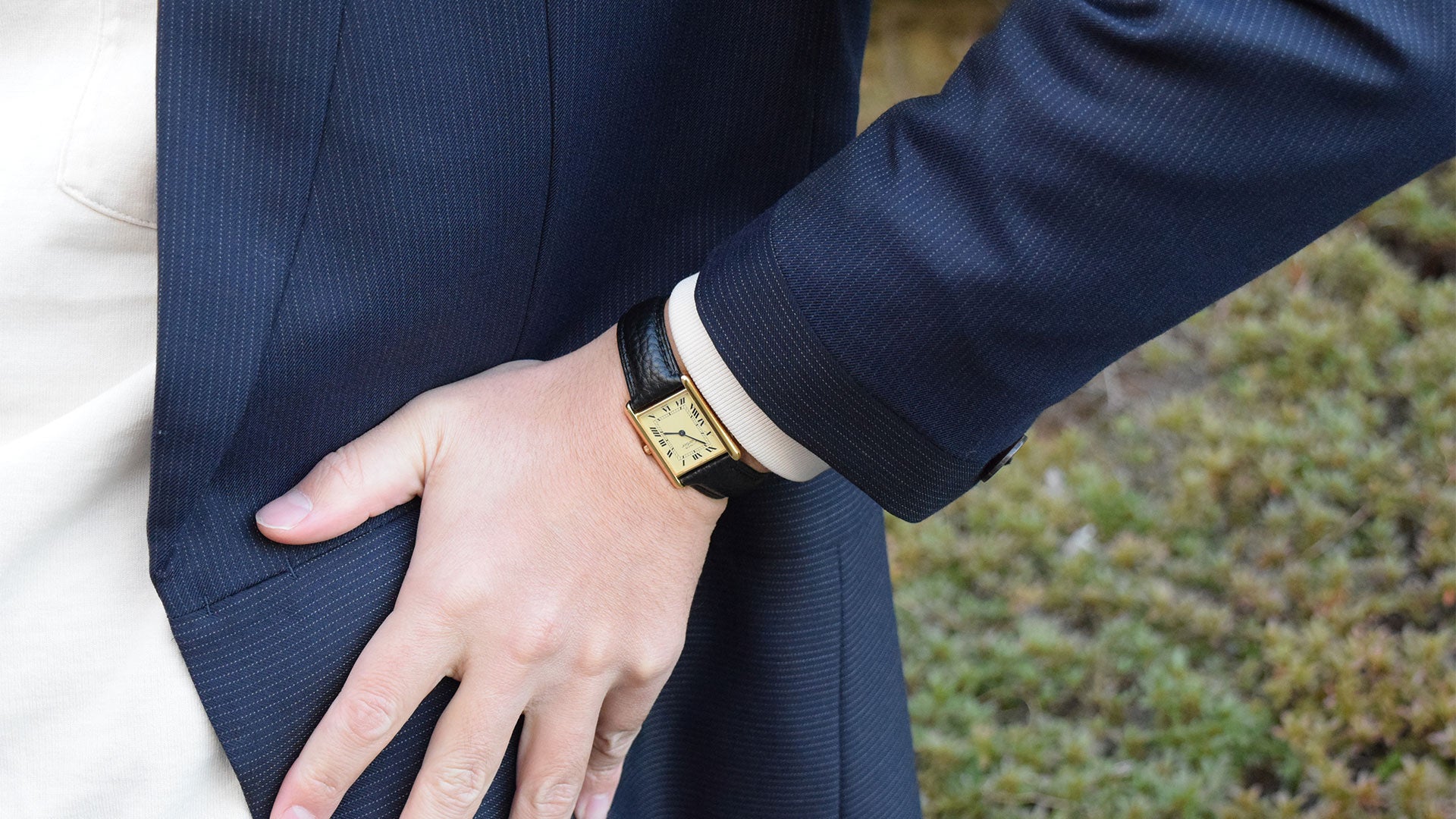
This is what it looks like from a distance.
It looks like me wearing it, and it's stylish.
Since it's a dress watch, it's not large, but I don't really need it to be big in the first place, and if I were to wear a jacket, I think it would be just the right size to stick down my sleeve.

This is a comparison between a distant view and a close up view.
With this shape, you can tell at a glance that it's a Cartier Tank, and although 23mm is small compared to current sizes, it still has plenty of presence.
Now, let's explain what the actual market for mast tanks is like.
When should I buy a mast tank?
As mentioned at the beginning, it is currently out of production, so you cannot purchase it even if you go to a boutique.
It will only be sold at vintage watch specialty stores that handle second-hand watches, so is that a small number?
That's not really the case.
As explained in the history section, production continued for nearly 30 years, so a considerable number were produced.
So, it's not that hard to find, but the prices are going up.
For example, there is a model called the Louis Cartier Collection released in 1973 that was produced in very limited quantities, so I think it's understandable that it's inevitable that the prices of these items will rise.
Because the production numbers are small.
However, considering the production volume of Mast Tank and how the price has risen in such a short period of time, it shows just how popular it is, and it really brings home the true power of Cartier.
This is just my gut feeling, but I feel like purchases have increased by 30% compared to a year ago.
It's not that I'm saying this, but my purchases have increased by 30% compared to six months ago.
It feels like the prices are rising quite quickly.
Of course, this is true not only for the Mast Tank but also for other discontinued models, but the Mast Tank is also becoming an expensive watch.
There are many limited edition models available, so it's difficult to say that the price range is specific, but the cheapest one is around 320,000 yen and the most expensive one is around 660,000 yen.
It is a feeling.
I think the overall average will be higher next year.
Therefore, when it comes to the timing to purchase, I think it's best to do so when you think "I want it..." or when you're unsure and think "This one is cute..."
If you're undecided, it means that you are somewhat inclined to want it, so in that situation, I think it would be best to just pick up the watch if it is there.
summary
I explained a bit about everything from basic knowledge about mast tanks to maintenance, size, and wearing comfort, and I think that you were able to acquire about 90% of the knowledge.
The best thing about this model is that it doesn't feel vintage and it fits comfortably on your wrist.
New items are great, but by looking at vintage models like this, you can have a wider range of choices, making shopping even more fun.



